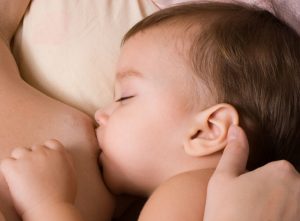By Deanna Soper-Pinkelman

When I first became a mom, I was struck with how frequently my son was waking up at night. Even though I am a trained biologist, I had no idea about the biology of newborn humans. In my blurry-eyed postpartum state, I struggled to understand why he wouldn’t just “sleep through the night.” As most academics, I first turned to the literature and to my lactation consultant (an IBCLC) to understand what was happening and why. Here are some of the things I learned along the way that didn’t necessarily help my sleep deprivation (thank you to coffee!), but rather helped me to come up with solutions that were beneficial for me and my baby.
- Infants have a different sleep pattern than adults. It is biologically normal for them to wake frequently at night.
Newborn infants need ten to twenty hours of sleep per day, but they generally sleep in 2-3 hour bouts (Elias et al., 1986). Adult parents may only require seven to eight hours per day that is, generally, consolidated into one sleep stretch at night with brief awakenings. Of course, this presents the problem of how to take care of the infant’s needs while trying to get enough sleep yourself. - Placing your baby on a separate sleep surface in a different room is a culturally-learned and reinforced practice.
Ancestrally, and in other indigenous populations today, humans sleep in groups and children co-bed (sleep in the same room on the same surface) with their mothers. Many parents mention that sleeping together when they are breastfeeding their infants helps them to get more sleep because neither they nor their babies have to fully wake in order to nurse. Even if the crib is moved to the parents’ bedroom (as is recommended by the American Academy of Pediatrics), this set up presents one big problem: baby will have to completely wake up and then wait to be picked up by a now-wide-awake parent. Despite this, not everyone feels comfortable having a baby in bed with them for various reasons.If you are in this category you might want to consider:
- Keeping the lights low, or operating with only a nightlight, which can help your brain and your baby’s brain stay in “sleep mode.”
- Ensuring to keep things that you might need handy by preparing the space prior to bedtime is also beneficial. This might mean pulling an extra diaper, having wipes at hand, and if you are nursing and supplementing or bottle-feeding exclusively, setting out the supplies you’ll need for easy access.
- Having a comfy chair right next to the baby’s crib will provide a convenient place to feed and get the baby back to sleep.
- If you are nursing and also sleeping with your baby, know that you are not alone.
A recent study found that 65% of breastfeeding mothers shared a sleep surface with their infants at some point during the first year of their infant’s life (Ball, 2003). Sleep researchers have found that when babies are breastfed and co-bed with mothers who are not medicated, do not smoke, and do not drink, they are at a lower risk for Sudden Infant Death Syndrome (SIDS) (McKenna and Dade, 2005; McKenna & Gettler, 2015).Co-bedding occurs, despite the current recommendation by the American Academy of Pediatrics, which states that infants should sleep on separate sleep surfaces (AAP, 2011, AAP, 2016), in the parents bedroom, for the first year of life (AAP, 2016). The updated 2016 AAP recommendations recognize that parents frequently fall asleep while feeding the infant, and given the significant increased risk of infant injury or death while sleeping on the sofa or arm chair, the AAP now recommends bringing the baby into bed for feeding, and if the parent falls asleep during the feed the infant should be returned to their own sleep surface when the parent wakes up. The AAP also recommends that bedding is removed so that infants do not become entrapped in it. Recent research by Dr. James McKenna, who is a professor at the University of Notre Dame, has found that method of feeding directly impacts risk of SIDS while using either co-bedding or separate sleep surface practices (McKenna, 2015). Breastfeeding mothers tend to naturally assume a position that requires the infant to be at breast height, sleep on their backs, and protects the infant from others nearby. In another recent paper, Drs. McKenna and Gettler have coined a new term ‘breastsleeping’ to indicate and separate a breastfeeding-cosleeping mother-baby pair as opposed to a non breastfeeding-cosleeping pair. The researchers also wanted to highlight the importance of continued mother-infant contact during sleep as it alters the physiology of the infant including respiration patterns, arousal, metabolism, and brain development (McKenna & Gettler, 2015). However, it is important for mothers to review the researcher-recommended safe sleep practices as certain sleep surfaces, such as sofas, have been found to be extremely unsafe. (See: Safe Co-Sleeping Guidelines). Another researcher at the University of Durham (UK), Dr. Helen Ball, has found similar results to Dr. McKenna and also has information on infant sleep here.
- Dr. Ball has identified SIDS to be a western post-industrialized issue. She has also found that co-bedding helps to reinforce the breastfeeding relationship.
Dr. Ball has pointed out that the conditions under which we (in Euro-American cultures) expect infants to sleep, and the conditions under which infants evolved, do not match (Ball and Russell, 2014). As a result, infants are born expecting constant contact with their mothers, but sometimes they do not receive it. Co-bedding means that you and your baby are in contact for a good portion of the night, making it easier to nurse and to continue nursing longer. In fact, Dr. Ball has found that bed-sharing during the first 13 weeks was a predictor of any breastfeeding at all, exclusive breastfeeding rates, and breastfeeding length after supplementation was started (Howel and Ball, 2013).
After reading this information, you might be left with the question: What do I do when my baby is night waking and upset?
No matter where you place your baby to sleep at night, it is important to know that night-waking is a common, biologically normal behavior. Although your baby may be doing this for a variety of reasons, you cannot do any harm by responding to your baby’s needs by nursing as needed at night. In the end, children do develop adult sleep patterns. Some children develop it earlier than others, as each child has their own developmental pace. If your baby is very upset at night (or even during the day), undress your baby and place him/her on your exposed chest in between your breasts while you are in the reclined position. (This is what I call the “home position.”) Here your baby will be able to listen to your heartbeat and smell you, which has a calming effect. Once calm, baby may drift off to sleep or may decide to nurse. Responding to your baby’s need to be close to you and nursing at night will strengthen the trust bond between you.
Ultimately, this time will pass and before you know it your baby will turn into a school-aged child who will (most nights) sleep eight to nine hours without waking. In the meantime, it is important to remember that night waking is a biologically normal behavior for infants, and how you meet the challenge of managing round-the-clock care should take into account both the baby’s evolutionarily derived biological needs as well as those of the rest of the family.
For support and questions regarding sleep or other breastfeeding issues, find the nearest Breastfeeding USA Counselor near you.
For further reading see:
Does Your Older Baby Still Need Night Feedings?
Ways to Get Your Baby to Sleep and Stay Asleep
Sweet Sleep: Nighttime and Naptime Strategies for the Breastfeeding Family
References
American Academy of Pediatrics. (2011). SIDS and other sleep-related infant deaths: expansion of recommendations for a safe infant sleeping environment. Pediatrics; 128: 1030-1039.
American Academy of Pediatrics. (2016). SIDS and other sleep-related infant deaths: Updated 2016 Recommendations for a Safe Infant Sleeping Environment. Pediatrics; 138; 1-5.
Ball, H. (2003). Breastfeeding, bed-sharing, and infant sleep. Birth; 30:181-188.
Ball, H.L. and Russell, C.K. (2014). SIDS and infant sleep ecology. Evolution, Medicine, and Public Health; 1:146. doi:10.1093/emph/eou023.
Elias M.F., Nicolson N.A., Bora C., Johnston J. (1986). Sleep/wake patterns of breast-fed infants in the first 2 years of life. Pediatrics; 77:322-329.
Howel, D. and Ball, H.L. (2013). Association between length of exclusive breastfeeding and subsequent breastfeeding continuation. Journal of Human Lactation; 29:579-585.
McKenna, J. and Dade, T. (2005). Why babies should never sleep alone: A review of the cobedding controversy in relation to SIDS, bedsharing, and breast feeding. Pediatric Respiratory Reviews. 6: 134-152.
McKenna, J. 2015, November 3. Why bedsharing among breastfeeding mothers will not be eradicated and what ethical (harm reduction) steps must be taken to accommodate it. American Public Health Association Annual Meeting and Expo. Chicago, IL.
MKenna, J. and Gettler, L.T. 2015. There is no such thing as infant sleep, there is no such thing as breastfeeding, there is only breastsleeping. Acta Pediatrica. 105. 17-21.
Deanna Soper-Pinkelman
Deanna Soper has a PhD in Biology from Indiana University and is an Assistant Professor of Biology at the University of Dallas. She is a Breastfeeding Counselor with the Cross Timbers Breastfeeding USA chapter.
© 2016 Breastfeeding USA, all rights are reserved.
